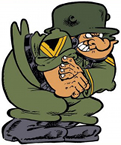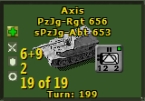briantopp
Posts: 190
Joined: 8/28/2006
From: Toronto
Status: offline

|
Some design notes:
My reference game is “Guderian’s Blitzkreig II” by The Gamers – a great wargame.
Weather: Weather was a crucial factor in this theatre, particularly during the first fall (1941) and winter (1941-1942). TOAW can simulate supply effects of weather well through supply radius and supple centre events, but less so the historical movement and combat effects. For example, during at least the first Russian mud season, most German units probably shouldn’t be able to move at all (certainly not more than a hex or two) except on a paved highway, and combat should be almost impossible. To give a bit of the flavour of this during mud and other weather states, I have tried to describe the weather’s relative effect by adjusting Axis shock and supply centre values up or down relative to the Soviets. I’ve also written in “pestilence” events to simulate frostbite. So:
eather state/Supply radius/Axis shock/Axis supply centre/Axis pestilence
Dry weather/12/110/100/0
Light mud/4/100/50/0
Mud/0/90/25/0
Light freeze/12/110/100/0
Medium freeze/6/90/100/1%
Deep freeze/3/80/75/2%
(I haven't fully implemented the supply centre variables yet but the key ones -- dry and mud -- are there).
Playing as OHK/OKH against a PO-controlled Soviet, I think you need to exercise some self-restraint during Russian mud turns or Moscow becomes too easy to capture in the first quarter of the game. Let’s say, during mud turns: no movement more than two hexes except by rail; and no multi-hex attacks (Elmer the programmed opponent doesn’t respect these rules, which is why there needs to be some corrective combat, but is programmed to be “very cautious”, and generally is). Playing PBEM against a human opponent, I suggest a house rule to the same effect: no movement of more than two hexes except by rail; no multi-hex combat (or, if you prefer and want to be more accurate, no combat at all by either side).
Stop line: As discussed, for example, on pages 1107-1111 in Horst Boog et al’s "Germany and the Second World War", volume IV, at the start of “Barbarossa” German logistics were capable of provisioning their forces within a radius of about 500 kilometers into the Soviet Union. In the area covered in this scenario this is sufficient, barely, to get to Smolensk. Arguably the Germans therefore could not supply their forces even as far as Moscow, and certainly could not do so to the Urals. So the Soviets were always going to have a safe hinterland in which to regroup and perhaps launch counter-attacks from. To simulate this, there is an “Axis stop line” drawn (generously, at least for the first year) to the east of Moscow. Axis units cannot ever advance past this line. If pushed over it in combat they must return the following turn or disband.
Axis spring 1942 replenishment: In the spring of 1942 the Germans executed a remarkable reconstruction of their shot-up eastern army. Not enough to return it to its June 1941 peak, but sufficient to defeat a series of Soviet counter-offensives and then to launch the ill-fated “Operation Blau”. To simulate this, a set of events will deliver a set of replenishment units which are immediately disbanded – providing the Axis side with a replenishment surge. If any of these units fail to disband due to some quirk, disband them manually. A theatre event also becomes available that will provide the Axis with a combat supply surge for two turns (by firing the event, the three German supply centres become 250-point supply centres instead of 100-point ones for two turns). This can be used to fuel an offensive – or it can be hoarded, to later help stop a Soviet one.
Axis tank production and TO&Es: German tank production is based on "Germany and the Second World War", volume IV, page 1120-1122 table II VI.I, which suggests that a 1% replenishment rate per turn is a generous estimate of what the Germans achieved at this point in the war. I’ve simplified the composition of the German tank park a little. The scenario ends before panthers, tigers and other modernized equipment seriously enters the war. The TO&Es of the individual panzer divisions are from Thomas Jentz’s "Panzer Truppen", volume 1, page 206.
Soviet armour: I’ve based the OOB and the TO&Es here on what you can read in Glantz’s "Colossus Reborn" (p 252 table 7.1 for the TO&Es, and page 165+ of the Companion book for the OOBs). The composition of the armour brigades morphs over time, and they become more proficient with time.
Supply centres: As noted above, the value of the Axis supply centres changes to show the relative efficiency of German logistics compared to the Soviets, and as a game-balance mechanism. Soviet supply centres are on the other side of the Axis stop-line and therefore cannot be attacked. The German supply centres are principal objectives of the Soviets and merit being carefully garrisoned and defended.
Bryansk train/siege artillery: As an interesting piece of chrome, the “Bryansk combat train” appears after the capture of Bryansk. Historically, it was used in the German attack towards Kursk but is of more limited usefulness here, alas. “Dora”, “Thor” and “Odin” – German railway siege guns – also make their appearance, on the assumption that a Moscow First strategy diverts them from Leningrad and Sevastopol. They can be highly effective but consume combat rounds.
Alarmeinheiten/workers’ emergency units: The Soviets receive a number of weak workers’ brigades (and eventually divisions) as emergency levies. The Germans receive something similar in the winter of 1942, with a set of “alarmeinheiten” units. They can be useful for rear-area security; as emergency cannon fodder to close a line; and if things are going usually well, can be disbanded to provide more replacements for front-line units.
Axis 29th and 30th corps: A theatre event allows the Axis player to call the 29th and 30th corps from reserve and into the battle. Historically, pulling these units into this theatre before the April 1, 1942 would have led to grave consequences for Army Group North – so take a 5 victory point penalty per corps for calling them in. They can be used for game balance. Use them if you think the Soviets are too strong. Leave them out if you think the Soviets are too weak.
Victory: Determine victory by counting Axis victory points, minus victory point expenditures (-5 for each of the 29th and 30th corps brought onto the map before April 1, 1942) and gains (+10 for killing Stalin, who sits in the well-defended Kremlin). Historically the Axis held 33 VPs at the end of this scenario. But balancing for the fact that army group centre will face the full force of the Soviet mid-war counter-attack, the Axis wins if it holds more than 12 VPs at the end of the game; the Soviets win by reducing the Axis to below this figure.
|
 Printable Version
Printable Version





























 New Messages
New Messages No New Messages
No New Messages Hot Topic w/ New Messages
Hot Topic w/ New Messages Hot Topic w/o New Messages
Hot Topic w/o New Messages Locked w/ New Messages
Locked w/ New Messages Locked w/o New Messages
Locked w/o New Messages Post New Thread
Post New Thread